Regrouping unfamiliar animals in the weeks prior to slaughter has few effects on physiology and meat quality in Bos taurus feedlot steers
I. G. Colditz A B G , D. M. Ferguson A B , P. L. Greenwood A C , V. J. Doogan A C , J. C. Petherick A E and R. J. Kilgour A FA Cooperative Research Centre for Cattle and Beef Quality, University of New England, NSW 2351, Australia.
B CSIRO Livestock Industries, F. D. McMaster Laboratory, Locked Bag 1, Post Office Armidale, NSW 2350, Australia.
C NSW Agriculture, Beef Industry Centre, University of New England, Armidale, NSW 2351, Australia.
D Queensland Department of Primary Industries and Fisheries, Locked Bag 4, Moorooka, Qld 4015, Australia.
E Queensland Department of Primary Industries and Fisheries, PO Box 6014, Rockhampton, Qld 4702, Australia.
F NSW Agriculture, Agricultural Research Centre, PMB 19, Trangie, NSW 2832, Australia.
G Corresponding author. Email: ian.colditz@csiro.au
Australian Journal of Experimental Agriculture 47(7) 763-769 https://doi.org/10.1071/EA05114
Submitted: 4 April 2005 Accepted: 14 December 2006 Published: 2 July 2007
Abstract
The response of cattle to alterations in social groupings can lead to physiological changes that affect meat quality. Feedlot practices frequently lead to a proportion of cattle in a pen being drafted for slaughter with the balance retained for a further period until they meet market specifications. An ability to regroup such retained cattle for short periods without consequences for meat quality would facilitate efficient use of feedlot pen space. The current experiment examined the impact on physiological variables and meat quality of regrouped British breed steers 4, 2 or 1 week before dispatch for slaughter. There was little effect of regrouping cattle on physiological variables associated with stress responses. Physical assessment of meat quality indicated that regrouping steers 1 week before slaughter led to higher compression and a tendency for higher peak force values in animals from one genotype than in their respective controls (1.89 v. 1.71 ± 0.05 kg, P = 0.017); however, these assessments were not matched by changes in sensory perception of meat quality. Average daily gain during feedlot finishing was negatively related to the temperament measure and flight time. It was also associated with breed, white cell count, plasma cortisol and haemoglobin at the midpoint of the 70-day finishing period. The results confirm the impact of flight time on growth rate during feedlot finishing and that regrouping cattle less than 2 weeks before slaughter may reduce meat quality.
Additional keywords: animal welfare, temperament.
Introduction
Cattle are social animals that can recognise their conspecifics (Hagen and Broom 2003). Disruption of the social grouping by separation from conspecifics or mixing with unfamiliar animals can lead to changes in behaviour and physiological processes (Veisseir et al. 2001) that are indicative of the adaptive response to a stressor (reviewed by Boe and Faerevik 2003). During stress responses, elevated activity of the hypothalamic–pituitary–adrenal axis and the sympathetic nervous system alters carbohydrate and lipid utilisation patterns that lead to increased glycogen catabolism in muscle and a change in energy metabolites in blood. Hormones associated with the stress response and the consequent changes in nutrient utilisation can also depress immune function and increase disease susceptibility (reviewed by Colditz 2002). Of primary importance in cattle experiencing stress prior to slaughter is the effect of reduced glycogen stores on post mortem muscle pH changes and meat quality (Ferguson et al. 2001). In addition, non-glycogen dependent effects of preslaughter stress on meat quality have also been identified (Simmons et al. 1997; Warner et al. 2007). In addition to the production costs associated with stress responses, it is generally accepted that the demand of responding to stressors can compromise the welfare of livestock. Thus an improved understanding of the stress associated with cattle husbandry practices is important both for animal welfare and production outcomes.
Many cattle production systems require the regrouping of animals to construct groups appropriate to husbandry and management practices. During feedlot finishing for instance, animals are often drafted out of a pen for dispatch to slaughter when they meet market specifications for weight and fat cover, with the remaining animals regrouped to economise on use of pen space. The potential impact of regrouping unfamiliar cattle on meat quality has led to specifications for handling cattle within the Meat Standards Australia (MSA) beef quality assurance scheme that include a prohibition on regrouping cattle from different groups or pens on a property within 2 weeks of dispatch (Anon. 2002). In addition, under MSA, cattle purchased from another property or a sale yard cannot be dispatched for slaughter within 1 month of purchase. It is pertinent to highlight here that these specifications were made without corroborating data. Rather, they were deemed appropriate as interim specifications in the interests of ensuring that meat quality was not compromised. Therefore, the current study was undertaken to examine the effect of regrouping unfamiliar feedlot cattle prior to slaughter on several physiological indicators of stress responses and meat quality. Also, associations between physiological variables, temperament, growth rates and meat quality were examined to investigate the potential costs to production and meat quality of adaptation to stressors encountered in the feedlot environment.
Materials and methods
Cattle
A cohort of 105 Hereford weaner steer calves ~9 months old were purchased from a single calving on a property near Goondoowindi, Queensland (−28°55′S, 150°31′E) and a second similar cohort of 105 Angus calves were purchased from a property near Armidale, New South Wales (−30°53′S, 151°62′E) in winter 2000. Prior to purchase and commencement of the experiment, the Hereford steers had been weaned by abrupt separation from their mothers and returned to pasture, whereas the Angus steers had been weaned by separation from their mothers then held in yards with free access to good quality dry feed and water for at least 5 days. The latter practice is known as yard weaning. The difference in weaning practice was not a deliberate design component of the study but is noteworthy in view of the influence weaning practices can have on feedlot performance of cattle (Fell et al. 1999). In practical terms, in this experiment weaning practice is confounded with breed and with other environmental and management differences related to the property of origin of the animals. After purchase, the Angus steers were run as a single group on pasture at ‘Tullimba’ Beef Cattle Research Facility, 50 km southwest of Armidale and the Hereford steers were run as a single group on pasture at CSIRO F. D. McMaster Laboratory in Armidale. One week before feedlot entry, the Hereford steers were trucked 50 km to ‘Tullimba’ and held in a paddock with no common boundaries to the paddock in which the Angus steers were grazing. Cattle, then ~12 months of age, were inducted to the feedlot on 22 September 2000 (day 1) and each cohort was allocated to a pen (40 by 50 m) separated by a vacant pen. At induction, cattle were treated at the manufacturers’ recommended dose rates for liver fluke (Fasinex, Novartis Animal Health) and internal parasites (Dectomex injectable, Pfizer), vaccinated against clostridial diseases, (CSL 5 in 1) and the brushes of their tails were trimmed. Dates of stock handling and treatments are summarised in Table 1. The cattle were weighed (Angus day 34, Herefords day 36) and temperament was assessed (Angus day 37, Herefords day 38) by scoring agitation on a five point scale while confined in the crush (Voisinet et al. 1997) and by measuring the time taken to traverse a 1.8 m distance after release from the crush, a trait termed ‘flight time’ (Burrow et al. 1988).
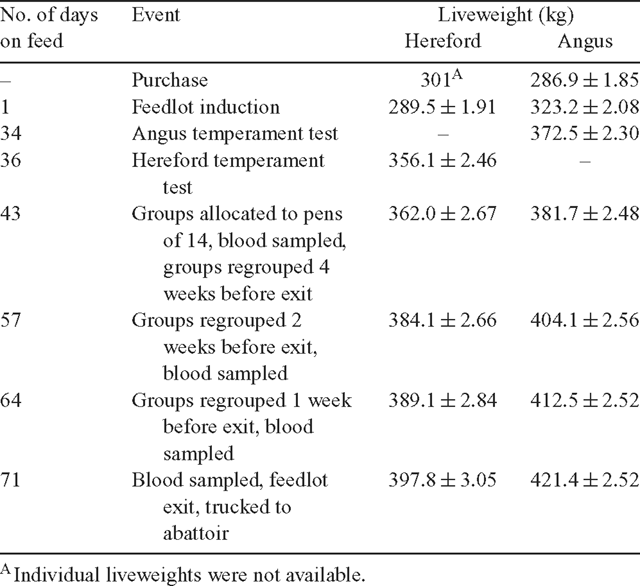
|
Experimental design
The experiment was designed to take animals from each property of origin, which also corresponded to their breed, and at 4, 2 or 1 week before dispatch for slaughter, mix or regroup these animals into pen units comprising animals from both breeds. For each breed, animals were assigned to treatments on day 43 by stratification on crush score then flight time and randomised to three replicates of five units of seven animals. Within each replicate, two units of seven animals were combined to provide 14 control animals, thereby creating one control group for each breed. The remaining units of seven animals were allocated to regrouping treatments so that seven steers from each breed were regrouped 4, 2 or 1 week before dispatch for slaughter on day 71. Thus, on day 43 (4 weeks before exit), the steers were divided from two large pens each containing 105 steers (providing 19 m2/animal and 0.38 m feed bunk per animal) into 15 pens (12.5 by 20 m) of 14 animals (providing 18 m2/animal and 0.83 m feed bunk per animal). The pens were in one row, thus there was the opportunity for some contact between animals in adjacent pens. Each pen had a single watering point and no shade. Steers allocated for regrouping 4 weeks prior to feedlot exit were moved into their treatment pens at this time, whereas those steers allocated for regrouping at 2 or 1 week prior to feedlot exit were run in pens of 14 with animals from their property-of-origin cohort until regrouping at 2 weeks. From 2 weeks until 1 week before exit, for each breed there was a pen of seven animals and a pen of 14 animals awaiting regrouping at 1 week before exit. When regrouped with unfamiliar steers at 2 or 1 week before slaughter, newly composed groups were moved to new pens to ensure that no animals returned to a ‘home’ pen. The three replicates of the five regrouping treatment pens were deployed in a block design across the feedlot. Allocation of cattle to groups is outlined in Table 2 and the deployment of groups in feedlot pens is documented in Table 3.
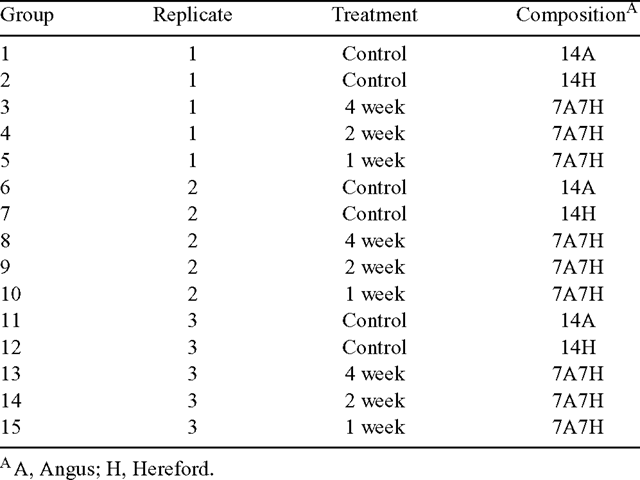
|
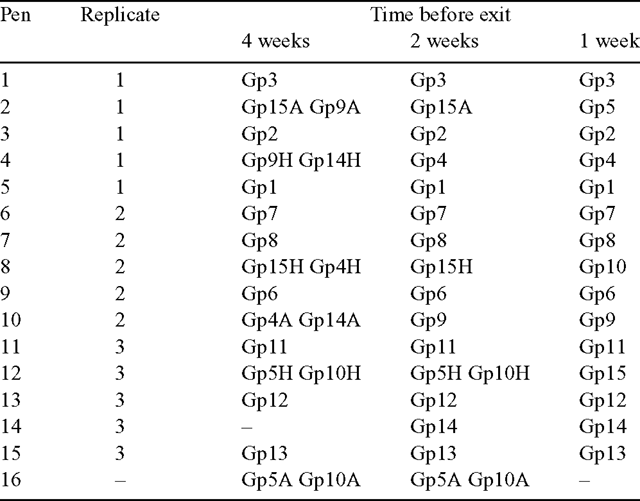
|
Cattle were offered standard feedlot ration (16.1% protein, 11.6% metabolisable energy) twice per day with refusals recorded for each pen and used to adjust the subsequent feed allocation. Steers were observed by trained stockpersons for signs of ill health after the morning feed. From day 43 onwards, on each occasion that cattle were handled, every experimental animal had a blood sample taken from the caudal vein while confined in a race and was then weighed (Table 1). Blood was collected into 2 by 10 mL EDTA vacutainers for haematology, plasma cortisol and plasma lactate assessments and into 1 by 10 mL heparin vacutainer for analyses of plasma glucose, urea nitrogen and creatine kinase. Blood samples were kept on ice and transported to the laboratory within 5 h of collection.
Slaughter
On day 71, cattle were trucked 80 km (~1 h) from ‘Tullimba’ to the abattoir and held overnight in lairage for 18–24 h before slaughter the following morning. The cattle were maintained in their treatment groups during trucking and lairage. The 15 groups were slaughtered in a random order to minimise any confounding effects due to slaughter sequence.
The cattle were stunned using a captive bolt pistol and bled immediately after stunning. The carcasses were electrically stimulated within 5 min of slaughter using low voltage stimulation (45 V, 14.3 pulses/s, unidirectional square wave) for 20 s. The carcasses were then placed in a chiller overnight.
Meat sample collection and analysis
After chilling for 18–20 h, the sides were boned and the M. longissimus thoracis et lumborum (LTL, striploin) was removed from one side for meat quality evaluation. The muscle was transversely cut into three equal sized portions and these were allocated to different aging treatments. The centre portion was aged for 14 days at 0–1°C and used for sensory evaluation by MSA consumer panels. The remaining portions were randomly allocated to either 1 or 14 days aging and used for physical measurement of meat quality.
A detailed description of the sensory evaluation protocol is provided by Polkinghorne et al. (1999). Briefly, at the completion of the aging period, the striploin samples were cut into five 25 mm cubes, allocated a unique code number and frozen and stored at –20°C. The cubes of meat were thawed (2–5°C) for 24 h prior to cooking on a Silex griller, then cooked to an internal temperature of 70°C, halved and allocated to untrained panellists. The panellists were allocated seven half cubes and were asked to score tenderness, juiciness, flavour and overall liking on a 100 mm line scale. These scores (1–100) were weighted to derive the overall acceptability of each steak, which was defined as the CMQ4 score. Each cube was evaluated by two panellists. Meat samples from 148 of the 210 animals in the experiment, balanced across breed and treatment, were assessed by panellists.
The physical meat quality measurements of ultimate pH (pHu), Minolta colour values (L*, a* and b*), compression, shear force and cooking loss were conducted on the 1- and 14-day aged samples according to the procedures outlined by Perry et al. (2001)
Blood sample analysis
Red and white cell parameters were estimated with a Cell-Dyn 3500R automated haematology analyser (Abbott Diagnostics, North Ryde, NSW, Australia) calibrated for cattle blood. Plasma cortisol concentrations were determined by radio-immunoassay using standards, antiserum and [125I] cortisol supplied by Orion Diagnostica (Espoo, Finland). Duplicate plasma (25 μL) samples and standards (100 μL) in the range 0–100 nmol/L, were assayed. The within assay CV was 5.3% and the between assay CV was 13.0%. The metabolites, glucose, urea nitrogen, creatine kinase and lactate were measured in plasma samples by autoanalyser using a Dade Behring Dimension clinical chemistry system (Dade Behring, Coorparoo, Qld, Australia).
Statistical analyses
Data were transformed where necessary to stabilise variances (Tables 6 and 7). Breed within pen group was used as the experimental unit for analysis of the effect of regrouping treatments on average daily gain (ADG), physiological indicators of stress and meat quality. Thus within pen, data for each breed were averaged to provide the value for that experimental unit and a separate analysis of variance performed for each breed. Feed data were available only on a whole pen basis. Meat quality data assessed on samples aged for 1 and 14 days after slaughter were analysed as a split plot in time fitting the effects of regrouping, aging period, and their interaction, again using breed within pen as the experimental unit. Contrasts between regrouping treatments and controls were performed by ANOVA. Associations between growth rate during 70 days of feedlot finishing and physiological variables (see Table 4) measured at the time of allocation of steers to treatment groups (day 43) were examined by multiple regression following a forward stepwise procedure (significance level for entry and removal = 0.150). Analyses were performed in Systat version 9 (SPSS Inc., Chicago, IL). Repeatabilities were calculated as the ratio of between animal variance to total variance when fitting animal as a random effect and treatment, breed and their interactions with time as fixed effects in ASREML (Gilmour et al. 2002). A probability less than 0.05 was considered significant.

|
Results
Cattle temperament
There was a significant correlation between flight time and crush score (R2 = 0.19, n = 210, P < 0.000). Weight at day 43, the day of allocation to treatments, was a significant covariate for each temperament measure (crush score, P = 0.011; flight time, P = 0.000). Fitting weight at day 43 as a covariate, there was no difference between breeds in crush score (adjusted least square means: Angus 2.00, Hereford 2.08, s.e.m. = 0.06, P = 0.363), and a tendency for flight time to be faster in Angus (adjusted least square means: Angus 0.85 s, Hereford 0.88 s, s.e.m. = 0.01, P = 0.09).
Cattle performance
Liveweight gain and feed intake of control cattle from day 43 until feedlot exit is presented in Fig. 1. During this interval, the Angus steers gained on average 39.7 ± 1.00 kg and Hereford steers 36.3 ± 1.26 kg. Allocation of Herefords to control group pens on day 43 resulted in a reduced feed intake that was not observed in control Angus cattle (Fig. 1). A substantial rain event occurred during the last 4 weeks of finishing with 123 mm falling in a 9-day period (Fig. 1), which resulted in decreased feed intake in the Hereford control groups in the week following the rainfall event.
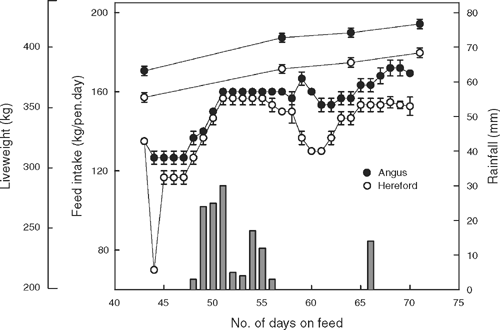
|
Effect of regrouping on growth rate, feed intake and physiological variables
Neither ADG (Table 4) nor feed intake (Table 5) was affected by the experimental treatments. There was little impact of treatment on physiological variables assayed on the day of exit. Plasma glucose was significantly higher in Herefords regrouped 4 weeks earlier than in controls (P = 0.016) and cortisol was significantly higher in Angus regrouped 4 weeks earlier than in controls (P = 0.011, Table 4).

|

|
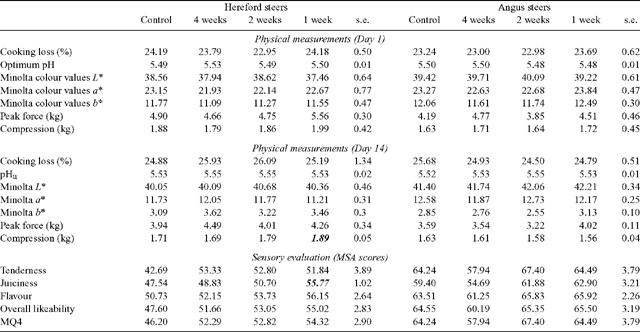
|
Effect of regrouping on meat quality
Samples from all treatments had a normal ultimate pH (i.e. pHu <5.7) in the LTL. After 14 days aging, LTL from Herefords regrouped 1 week before feedlot exit had significantly higher compression values than controls (P = 0.017). Taste panel appraisal of eating quality showed a significant increase in juiciness of meat from Herefords regrouped 1 week before slaughter (P = 0.003). Other eating quality traits were not affected by treatment (Table 5).
Associations between physiological variables and growth rate or meat quality
There was a significant relationship between ADG during the 70 days of feedlot finishing and flight time and physiological variables assessed on day 43 of feedlot finishing yielding the following equation (R2 = 0.26, n = 210):

where FT is square root flight time (s), breed is Angus (1) or Hereford (2), wcc is log10 white cell count, cort is cortisol (nmol/L), hgb is haemoglobin concentration (g/dL) in blood or plasma and values in brackets are the probabilities and correlations of each variable with ADG, given the inclusion of the preceding terms in the model.
Repeatabilities for the physiological variables that were measured on four occasions (Table 1) were white cell count (0.44), cortisol (0.54) and haemoglobin (0.67).
For meat quality traits, a significant relationship occurred between compression measures (aged 1 day) and breed, treatment and cortisol measured on day 42 as follows (R2 = 0.23, n = 210):

where the values in brackets are the probabilities and correlations of each variable with compression given the inclusion of the preceding variables in the model.
Discussion
During feedlot finishing, there is often a requirement to regroup animals that need a further period on feed to reach market specifications. In the current experiment, the animals that were regrouped were mixed in equal numbers, and were all steers of similar size and weight at the time of regrouping. There was little impact of regrouping on physiological variables that are frequently found to be influenced by stressors such as transport and feedlot entry (Fell et al. 1999). The only significant changes observed were an elevation of blood glucose in Hereford cattle regrouped 4 weeks before exit and an elevation of cortisol in Angus cattle regrouped 4 weeks before exit. The substantial rain event that occurred during the experiment (Fig. 1) affected feed intake of Herefords between days 57 and 65 and this may have confounded or reduced the impact of experimental treatments. Nonetheless, blood cortisol measurements taken before and after the rain event had a moderate repeatability and the effect of time on cortisol when analysed by repeated measures analysis was not significant (data not shown). ADG fluctuated substantially across treatment groups (Table 4). This variation did not lead to marked differences in haematological variables and its implications remain unresolved. Taken together, it is likely that in the current experiment the regrouping of animals during the weeks prior to feedlot exit did not provoke a strong stress response.
With respect to meat quality, increased compression and peak force values are usually associated with consumer perceptions of tougher meat (Perry et al. 2001). For Herefords, steers regrouped 1 week before feedlot exit had significantly higher compression values than control steers. In accord with this finding was the observation that breed and treatment, together with cortisol, were significant terms in the stepwise regression of experimental factors on compression. Nonetheless, sensory appraisal of meat did not detect a diminution of eating quality associated with regrouping. Animals sourced for this study were not necessarily representative of their breeds and the two breed cohorts experienced different rearing conditions and management before entry to the experiment. It is, therefore, not necessarily valid to conclude that differences between the response of Angus and Hereford cattle to regrouping in the current experiment is indicative of breed differences. The constraints of logistics and expense make experiments on group responses of cattle difficult to design with sufficient power to detect small but important consequences for meat quality.
Cattle used in the current experiment came from two large commercial herds, one of which (Angus) had been yard weaned. These cattle also differed in their average growth at pasture prior to feedlot entry (Hereford –144 g/animal.day v. Angus + 454 g/animal.day) due, at least in part, to differences in pasture availability and quality at the two grazing sites and prevailing drought conditions. However, other cattle studies (Purchase et al. 2002; Sazili et al. 2004) suggest it is unlikely that the duration of pasture feeding between purchase and feedlot entry, and the rates of growth during that period, would have serious consequences for eating quality of beef following 70 days in the feedlot.
Although no pronounced effects of experimental treatments on growth rate and physiological variables were detected in the experiment, the animals may nonetheless have varied in their capacity to cope with the feedlot environment and thereby have experienced differing levels of activation of stress response pathways during their time in the feedlot. In view of the potential for antagonism between stress responses and growth, associations between growth during feedlot finishing and the suite of physiological variables measured midway through finishing (before commencement of experimental treatments) were examined. Treatment was not found to influence growth rate. Growth rate was associated with breed, positively associated with flight time and white cell count and negatively associated with cortisol and haemoglobin levels in blood. The term breed in this analysis encapsulates not only genetics of the two lines but also the effects associated with property of origin, and pre-feedlot entry management. Flight time is a measure of temperament of cattle that has been found to be genetically correlated with growth rate (Burrow et al. 2001; Petherick et al. 2002) and genetically (Reverter et al. 2003) and phenotypically (Voisinet et al. 1997; Petherick et al. 2002) correlated with meat quality in Bos indicus derived breeds. In addition, B. indicus and B. indicus cross cattle with short flight times tended to lose more weight during long distance road transport and recover weight more slowly in the month following transport than animals with slow flight times (H. M. Burrow and I. G. Colditz, unpubl. data). The present results support those found in a previous study on British breed steers, where ADG over 78 days in a feedlot was positively correlated with flight time and negatively correlated with cortisol levels (Fell et al. 1999). The current results, therefore, confirm that slow flight time is a desirable trait associated with faster weight gain during feedlot finishing of cattle, and extended this finding to Bos taurus cattle. Although statistically significant, the impact of white cell count, cortisol and haemoglobin concentration on ADG were minor in comparison with flight time and breed. Nonetheless, the negative association between cortisol and ADG is in accordance with the effect of cortisol on muscle catabolism.
In view of the potential for the detrimental impact of concurrent stressors to combine in an additive or even synergistic fashion, it seems prudent to adopt a conservative interpretation of the results of this experiment. Thus while only a low level of significance was found, it suggests that within 2 weeks of slaughter, cattle enter a period when stressors may compromise meat quality. Minimising the exposure of cattle to stressors during this period seems appropriate in the interests of maximising beef eating quality. In addition, the large differences in meat quality observed between cattle from the two properties of origin indicate that there are factors with substantial effects on meat quality that are yet to be identified.
Acknowledgements
The skilled and dedicated assistance of Reid Geddes and his colleagues at ‘Tullimba’ Cattle Research Facility, and David Paull, Brad Hine, Callum Mack, Dominic Niemeyer, Keryn Hutton, Reg Woodgate, Bill Johns, Steve Sinclair, Joe Brunner, Stuart McClelland, Janet Stark and the late Brian Anderson is gratefully acknowledged. We thank Rod Polkinghorne from Meat Standards Australia for coordinating the consumer sensory evaluations.
Boe KE, Faerevik G
(2003) Grouping and social preferences in calves, heifers and cows. Applied Animal Behaviour Science 80, 175–190.
| Crossref | GoogleScholarGoogle Scholar |

Burrow HM,
Seifert GW, Corbet NJ
(1988) A new technique for measuring temperament in cattle. Proceedings of the Australian Society for Animal Production 17, 154–157.

Burrow HM,
Moore SS,
Johnston DJ,
Barendse W, Bindon BM
(2001) Quantitative and molecular genetic influences on properties of beef: a review. Australian Journal of Experimental Agriculture 41, 893–919.
| Crossref | GoogleScholarGoogle Scholar |

Colditz IG
(2002) Effects of the immune system on metabolism: implications for production and disease resistance in livestock. Livestock Production Science 75, 257–268.
| Crossref | GoogleScholarGoogle Scholar |

Fell LR,
Colditz IG,
Walker KH, Watson DL
(1999) Associations between temperament, performance and immune function in cattle entering a commercial feedlot. Australian Journal of Experimental Agriculture 39, 795–802.
| Crossref | GoogleScholarGoogle Scholar |

Ferguson DM,
Bruce HL,
Thompson JM,
Egan AF,
Perry D, Shorthose WR
(2001) Factors affecting beef palatability – farmgate to chilled carcass. Australian Journal of Experimental Agriculture 41, 879–891.
| Crossref | GoogleScholarGoogle Scholar |

Hagen K, Broom DM
(2003) Cattle discriminate between individual familiar herd members in a learning experiment. Applied Animal Behaviour Science 82, 13–28.
| Crossref | GoogleScholarGoogle Scholar |

Perry D,
Thompson JM,
Hwang IH,
Butchers A, Egan AF
(2001) Relationship between objective measurements and taste panel assessment of beef quality. Australian Journal of Experimental Agriculture 41, 981–989.
| Crossref | GoogleScholarGoogle Scholar |

Petherick JC,
Holroyd RG,
Doogan VJ, Venus BK
(2002) Productivity, carcass and meat quality of lot-fed Bos indicus cross steers grouped according to temperament. Australian Journal of Experimental Agriculture 42, 389–398.
| Crossref | GoogleScholarGoogle Scholar |

Purchase RW,
Burnham DL, Morris ST
(2002) Effect of growth potential and growth path on tenderness of beef longissimus muscle from bulls and steers. Journal of Animal Science 80, 3211–3221.
| PubMed |

Reverter A,
Johnston DJ,
Ferguson DM,
Perry D,
Goddard ME,
Burrow HM,
Oddy VH,
Thompson JM, Bindon BM
(2003) Genetic and phenotypic characterisation of animal, carcass, and meat quality traits from temperate and tropically adapted beef breeds. 4. Correlations among animal, carcass, and meat quality traits. Australian Journal of Agricultural Research 54, 149–158.
| Crossref | GoogleScholarGoogle Scholar |

Sazili AQ,
Lee GK,
Parr T,
Sensky PL,
Bardsley RG, Buttery PJ
(2004) The effect of altered growth rates on the calpain proteolytic system and meat tenderness in cattle. Meat Science 66, 195–201.
| Crossref | GoogleScholarGoogle Scholar |

Simmons NJ,
Young OA,
Dobbie PM,
Singh K,
Thompson BC, Speck PA
(1997) Post-mortem calpain-system kinetics in lamb: effects of clenbuterol and pre-slaughter exercise. Meat Science 47, 135–146.
| Crossref | GoogleScholarGoogle Scholar |

Veissier I,
Boissy A,
dePassille AM,
Rushen J,
van Reenen CG,
Roussel S,
Andnason S, Pradel P
(2001) Calves’ responses to repeated social regrouping and relocation. Journal of Animal Science 79, 2580–2593.
| PubMed |

Voisinet BD,
Grandin T,
O’Connor SF,
Tatum JD, Deesing MJ
(1997) Bos indicus cross feedlot cattle with excitable temperaments have tougher meat and a higher incidence of borderline dark cutters. Meat Science 46, 367–377.
| Crossref | GoogleScholarGoogle Scholar |

Warner RD,
Ferguson DM,
Cotterell JJ, Knee BW
(2007) Acute stress induced by the preslaughter use of electric prodders causes tougher beef meat. Australian Journal of Experimental Agriculture 47, 782–788.
| Crossref | GoogleScholarGoogle Scholar |



